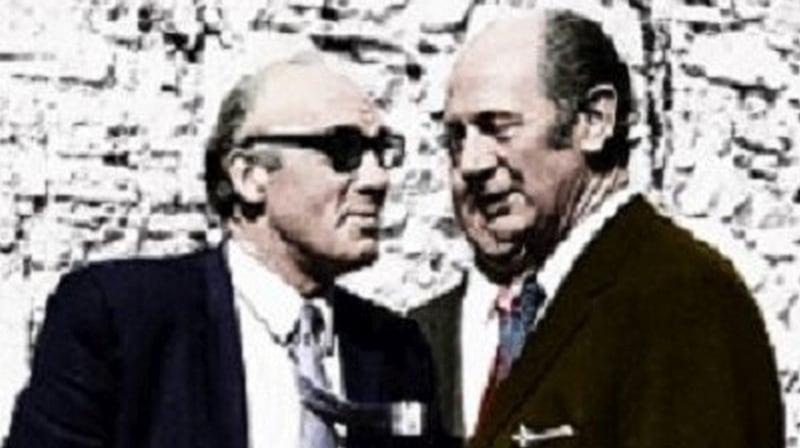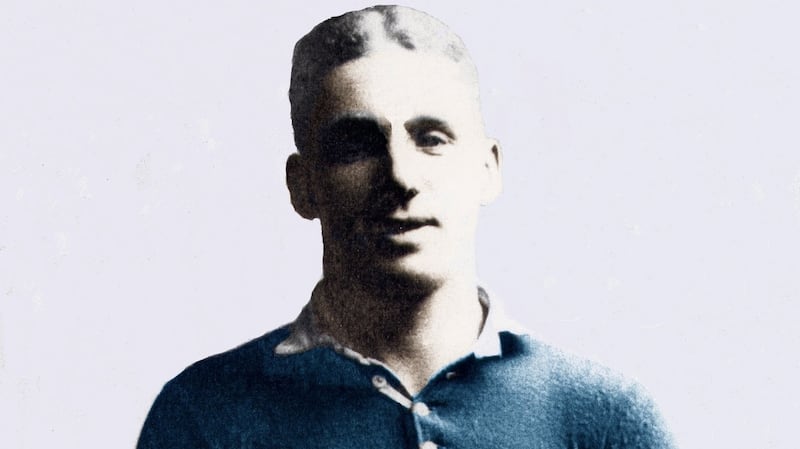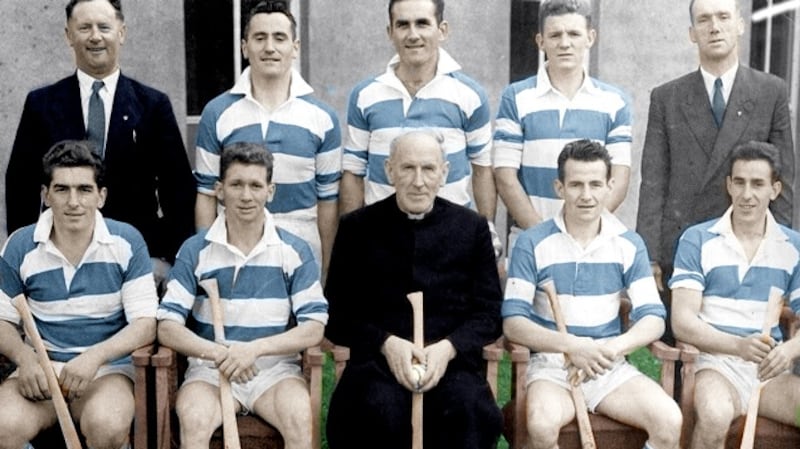Tomás Ó Cinnéide remembers his uncle, the Waterford hurler John Keane, in an image that comes flaming through the spent century.
“After my father died in 1941 we went to live in the house at Barrack Street. John was still living there and he took a particular interest in me as the only boy in my family,” he told his cousin, David Smith.
“John married Auntie May in 1945 but he continued to care for me and he brought me to matches everywhere he could. I have a vivid memory of that 1948 game and of walking back to Thurles from the field with John, who was still in his togs, and the multitudes of people cheering him and clapping him on the back.
“But the memory that made the most impression on me was the sight of his two hands covered in dried blood and his knuckles torn to shreds. It made me realise that hurling was a man’s game and there was a price to be paid for all that cheering and back slapping.”
John Keane belongs to a disappeared Ireland and has become one of the mythological creatures of an all but disappeared game. All-Ireland hurling champions Limerick visit Waterford on Sunday amid much fretting and agonising of the transformation of hurling into a game that has become unrecognisable to its custodians. Keane’s hurling life is one of dense, pioneering accomplishment.
It’s clear, from the recollections of those who remember him, that the Mount Sion man was, essentially, an athletic freak. He excelled at the lot – swimming, gymnastics, Gaelic football, athletics. But hurling was his calling. Waterford were in the doldrums when he made his debut in 1935, aged 17 against Cork on a February Sunday in the Mardyke.

Three years later, the county contested its first senior All-Ireland final against Dublin. Keane was a veteran and an established star by the time Waterford won the Liam MacCarthy Cup for the first time, a decade later, in the 1948 final against Dublin. He retired two years later but was back in Croke Park as trainer of the team that won Waterford’s next – and most recent – All-Ireland in 1959against Kilkenny. His fingerprints are all over Mount Sion’s utter domination of the local scene in the 1950s.
The story of his last days is remarkable, at once profoundly sad and wonderfully gallant. Gravely ill, Keane embarked on a private hurling odyssey, touring the country to visit hurling rivals with whom he had developed enduring friendships. He was on his way to see Mick Mackey when he became weak on the road to Limerick and died shortly afterwards, on October 1st, 1975. Keane was just 58 years old.
“There never was, nor will be, a greater hurler than John Keane,” an emotional Mackey said at his funeral.
And throughout his hurling career, Keane was spoken of in the superlative terms reserved for Christy Ring and Mackey. But in the 40 years since his premature death, with precious little archive footage and the newspaper cuttings yellowing, he has sort of been wiped out of that equation.
“I personally think that John is like Cúchulainn,” says David Smith.
“It is like he never existed but he is there in people’s consciousness. Ah, greatest hurler, John Keane. That is about all people know. That is why I so badly wanted to write this bloody book.”
Strong bond
In 2011 Smith published The Unconquerable Keane, an assiduously researched account of his uncle’s life which includes a wealth of interviews with family members and friends. In Smith’s imagination, Keane has always held a vivid place in which he could move effortlessly from hurling gargantuan to easygoing uncle.
“John was the second youngest in his house,” Smith explains.
“My mother played camogie so there was a strong bond between them. He was the youngest boy but he looked after everyone. He kept a watchful eye on the children of his brothers and sisters. For instance, my father died when he was 44 from leukaemia. My mother was left with six children and he was buried on her 40th birthday, October 9th.
“John was in the background making sure we were okay. He helped out with money and getting things done for my mother. He had a posse of kids always walking after him. I was one of those kids. But he wasn’t John Keane the great hurler. He was my uncle.”
He was also the personification of the post-Treaty Irish life, whip-smart and reducing his schooling to a part-time basis at the age of 15 so he could work the local timber company and bring in money for the family. He was physically striking, a born athlete capable of walking the length of Barrack Street on his hands for pure high spirits.
He was sociable by nature and well suited to be the publican he later became. Like many of his generation, he smoked with abandon and became a pioneer after he married. But what has perhaps been forgotten, perhaps even in parts of Waterford, is the exalted regard in which he was held. Here’s a description in the Sunday Dispatch of his contribution to Waterford’s big day in 1948.

“He has inspired colleagues to give of their very best all the time. He has brought peak form out of attacking colleagues who benefitted from Keane’s craft and experience . . . he is a net-conscious centre half forward – a 31-year-old wizard whose opportunism, tricks, marksmanship and co-operation with his wingers all combine to bewilder the defence.
“In generations to come, when there is reference to Waterford’s breaking of the ice by the taking of the GAA’s 61st senior hurling championship, praise in plenty will be given to Keane’s big part in the 1948 decider.
“Not alone was he top scorer for the winners on September 5th – he waved five of Waterford’s thirteen flags, getting three goals and two points out of a total of 6-7– but he was man of the match in other ways also. Sequel was that, when the excitement really blazed up, with the referee blowing for full-time and a glorious Waterford win, it was to John Keane that most of the other players and thousands of supporters rushed first to congratulate him, hug him, kiss him, cry over him, carry him in wild tribute all around Croke Park . . . it was a fitting climax to a decade and a half of sporting endeavour.”
Hazy black and white film of the day survives, clear enough to offer an impression of Keane’s strength and athleticism but not of the quality of hurling. At that stage in his career, he was essentially moonlighting as a forward, having originally established himself as a stellar centre back who distinguished himself as Mackey’s prime defensive opponent.
From their first riveting encounter, in the Munster championship of 1937, they were linked: so too were Waterford and Limerick for that generation of followers. It was for his defensive showings that the GAA writer Séamus Ó Bréanáin included Keane in the pick of hurlers of a heightened era.
Flickering presence
“It was a formidable age to be young and those were formidable stars who set our standards for us . . . it makes it hard for the players we see today to achieve any sort of eminence in our eyes: they must inevitably stand the test against a boyhood view of Ring and Mackey and Keane.”
But time has obscured Keane from the public portrait of that triumvirate. Ring holds a pre-eminent place in GAA folklore. Mick Mackey’s presence is wedded to Limerick hurling. Waterford, however, were a flickering presence on the big days of hurling after Keane’s generation left the stage. Of the county’s nine Munster titles, Keane was directly involved in four.
From 1963 until the rebirth in 2002, Waterford went without any Munster title: more than enough time for Keane’s legend to fade out of mind and conversation.

Still and all, he waltzed on to the Hurling Team of the Century and was also chosen, at number six, for the Hurling Team of the Millennium. The accomplishments are gold standard even if Waterford is easygoing about him.
“We are called the Gentle County,” says Smith. “We don’t raise our voices at all. Waterford is a smaller county and we suffer from that. He was as good as the rest but without the political clout that the people who saw him play knew how good he was. There is no film of them. With Shefflin and Carey and Ken McGrath there is video evidence there of what they did.”
Pat Fanning the former GAA president and a lifelong friend, told Smith that they knew Keane was poorly in the autumn of 1975. He had circulation problems, particularly in his legs, which led to heart complications.
“John would have taken plenty of blows to his legs from hurling. That probably didn’t help either,” Smith points out.
The idea of amputation had been broached. Keane told Fanning: “I’d rather go whole.”
Whether in spite or because of his condition, he set off by car that last week in September, heading first to see Jimmy Langton in Kilkenny for an evening. Then he headed across to Cork to meet Jack Barrett. From there he drove to Tralee, where Jackie Power, the former Limerick player, lived.
“They were wonderful friends,” David Smith says.
One can only guess at the conversations and what the other hurlers made of Keane’s impulsive visit. The family reckons that they probably guessed the reason behind it.
“I think they must have known,” Smith says.
“Pat Fanning told me he was visibly dying. Pat was in wonder that he made it as far as he did. He never asked John about it, even though they were as close as brothers. John must have known. He was a very intelligent man.”
Mick Mackey was to be next on the tour but he only made it to Tarbert. A few days later, many of the old men against whom Keane had played made their own pilgrimage to see him laid to rest.
Long after they retired the sight of Limerick and Waterford colours swirling still conjures a vision of Keane and Mackey locked in competition. Time has diluted those images but the current conversations about what hurling has become can be traced back to the closeness and fierceness of those phosphorescent duels.
Their on-field rivalry riveted a generation for whom distractions were few – and their friendship continued through to the very end. John Keane sometimes said: “If I couldn’t live in Waterford then Limerick is where I would choose.”
No higher compliment.
The Unconquerable Keane is available for free in e-book format. Anyone who wishes to receive a copy can contact the author at theunconquerablekeane@gmail.com.

















